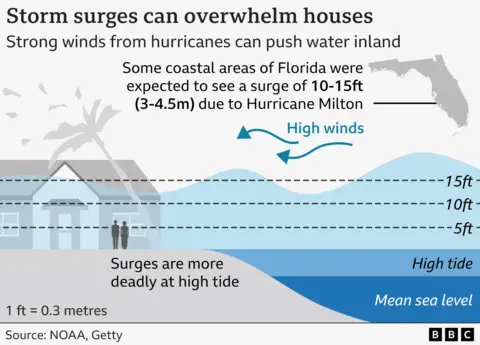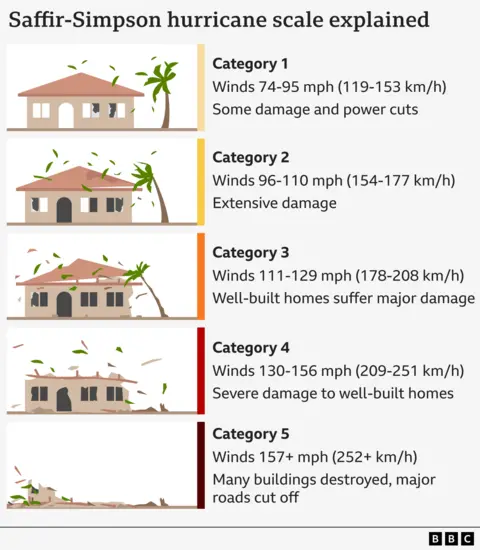Hurricane Milton weakened to a Category 1 storm after striking the Florida peninsula, with its center moving out of the state and into the Atlantic Ocean.
But forecasters warned that hurricane-force winds and rain were continuing in the eastern part of the state.
The storm comes just two weeks after Hurricane Helen caused extensive damage across the southeastern United States.
When did Hurricane Milton hit Florida?
According to the National Hurricane Center, Milton was a Category 3 hurricane in Siesta Key, Florida, a coastal area about 50 miles (80 km) south of Tampa, as of 20:30 ET on Wednesday (03:30 on Thursday). It is said to have landed in . (NHC).
By Thursday morning, nearly 3.4 million homes were without power, dozens of homes were destroyed and at least four people were reported dead.

Forecasters continue to warn of the potential for heavy rain, flash flooding, strong winds and storm surges reaching several feet in height (which occurs when water moves inland from the coast) along the northeast Florida coast.
At least 116 tornado warnings were issued across Florida on Wednesday, and 19 twisters have been confirmed so far in the state, Gov. Ron DeSantis said at a news conference Wednesday evening.


Where is Hurricane Milton?
The most recent recorded wind gusts reached up to 85 mph (140 km/h), and Milton is currently heading toward the Atlantic Ocean and is expected to pass north of the Bahamas later on Thursday.
Its large size means the effect feels much wider than the shaded cone shown above.
In addition to most of Florida, the storm’s effects were also felt in Georgia and South Carolina.
During its multi-day journey, Milton tracked east from the Gulf of Mexico, where it was classified as a Category 1 hurricane on Sunday. It also affected Mexico’s Yucatan Peninsula.
Before hitting Florida, forecasters said it “swinged” south, which prompted forecasters to change its path slightly.
The storm impacted some areas recently damaged by Hurricane Helene. Tampa, which has more than 3 million people in the larger metropolitan area, is just north of Siesta Key, where the storm made landfall.

Where are the Hurricane Milton evacuation zones?
Traffic gridlocked and airports announced closures as Floridians were told to prepare for the state’s largest evacuation effort in years. Officials said Milton could be the worst storm to hit the region in about 100 years.
As the hurricane approached, most counties officially declared states of emergency and evacuation orders were issued throughout Florida’s west coast.
Disaster management authority issued Lists and Maps Evacuation orders were issued across dozens of counties. Several large shelters were also set up as a last resort for those who were stranded.

What is a hurricane and how do they form?
A hurricane (sometimes called a cyclone or typhoon) is a type of tropical storm that forms in the North Atlantic. They bring strong winds and heavy rain.
When ocean air is warm and humid, it rises and then begins to cool, forming clouds.
Sometimes rising air can move faster than it can be replaced at the surface at the top of a hurricane, causing surface pressure to drop.
As pressure drops, the winds accelerate and are pulled in with more air, making the hurricane stronger.
The National Oceanic and Atmospheric Association (Noaa) predicts that the 2024 hurricane season will be more active than usual. They said rising average ocean temperatures due to human-caused climate change were partly to blame.

How are hurricanes classified?
Hurricanes are divided into five categories based on wind speed:
Milton was classified as a Category 5 storm (the highest level) on more than one occasion, but weakened as it approached the U.S. coast, hitting a Category 3 storm.
After landfall it was further downgraded to Category 1.

How is climate change involved?
Hurricane Milton quickly strengthened as it passed through unusually warm waters in the Gulf of Mexico, where sea surface temperatures were about 1 to 2 C above average.
Warmer waters mean hurricanes can absorb more energy, potentially resulting in higher wind speeds.
A warmer atmosphere can hold more moisture. This increases by up to about 7% for every 1 degree increase in temperature. This means that rainfall from hurricanes could be more intense.
And in recent decades, global sea levels have been rising due to global warming.
This makes coastal flooding more likely to occur with any given storm surge.
Average sea levels in Florida have risen more than 7 inches (18 cm) since 1970, according to U.S. government data.
A full scientific analysis is needed to quantify the exact role of climate change in Hurricane Milton.
But the rapid strengthening is consistent with expectations for how these storms are changing in a warming world.



